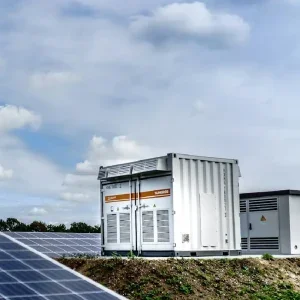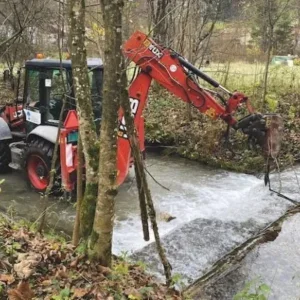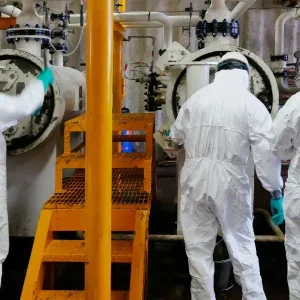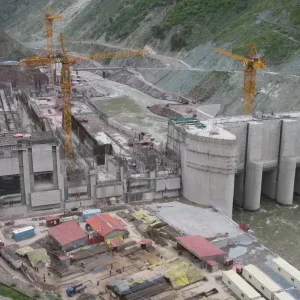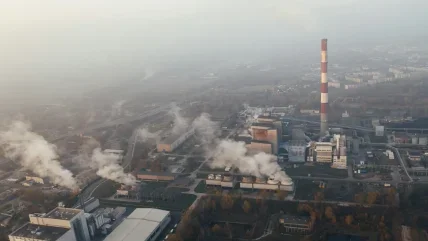
In early February, the US Department of Energy (DOE) Office of Clean Energy Demonstrations (OCED) announced up to $304 million in funding for four projects to “pilot transformational technologies designed to capture carbon dioxide emissions that would otherwise accelerate climate change and jeopardise public health.”
Funded by the Bipartisan Infrastructure Law, these large-scale pilot projects — located at power and industrial sites in Kentucky, Mississippi, Texas, and Wyoming — have the potential to prevent more than 500 000 metric tons of CO2 emissions from being released into the atmosphere each year, says USDOE.
As part of the Biden-Harris Administration’s commitment to advance environmental and energy justice in partnership with communities, the projects receiving awards will be required to implement a comprehensive Community Benefits Plan — which will be “informed by early and meaningful community and labour engagement.”
The four projects announced in early February as “having been selected for award negotiation” are part of the Carbon Capture Large-Scale Pilot Projects Program, which supports projects that implement carbon capture technologies at the pilot scale across the power and industrial sectors. The selected projects are “designed to pilot transformational carbon capture technologies and catalyse significant follow-on investments for commercial-scale demonstrations on carbon emission sources”, in support of meeting the Biden-Harris Administration’s goal of a net-zero emissions economy by 2050.
One of the proposed projects is at a pulp and paper mill (Vicksburg Containerboard Mill, Mississippi), one is at a refinery (Big Spring, Texas) and two are planned to be located at power plants:
Cane Run generating station, Louisville, Kentucky
The carbon capture pilot at Cane Run, led by PPL Corporation (PPL), will deploy a carbon capture system at unit 7 of PPL subsidiaries Louisville Gas and Electric and Kentucky Utility companies’ Cane Run generating station, a natural gas fuelled combined cycle power plant with 640 MWe capacity in Louisville, Kentucky. The project expects to capture 95% of the carbon dioxide from the unit’s flue gas using an advanced “heat-integrated” CO2 capture technology. Developed by the University of Kentucky (UK), this technology aims to capture up to 90,000 metric tons of CO2 per year. The project team plans to partner with an off-taker which will purify the captured carbon dioxide for use as beverage-grade CO2. Natural gas-fired power plants in the United States currently produce more than 1.7 billion metric tons of CO2 emissions each year. The goal of the project is said to be to pilot safe and responsible carbon capture by designing, building, operating, and analysing the UK solvent-agnostic process to enable its replication at other natural gas-fueled combined cycle power plants. This project, with an anticipated federal cost share of up to $72 million, builds on concurrent DOE carbon capture research and development focused on the UK solvent-agnostic process through the DOE Office of Fossil Energy and Carbon Management.
PPL and its subsidiaries have a long-standing history of partnership with local community stakeholders surrounding the Cane Run power plant and the broader Jefferson County community. In collaboration with community stakeholders, the project team will investigate the potential for a Community Benefits Agreement. The team already employs workers from the International Brotherhood of Electric Workers, and the pilot project expects to create additional construction jobs. As part of its Community Benefits Plan, the project will expand existing training and internship programmes to create a project workforce development plan that involves collaborating with local community leaders and organisations and partnering with local colleges and universities, including a local Historically Black College and University, for implementation.
Dry Fork power station, Gillette, Wyoming
The carbon capture pilot at Dry Fork power station, led by TDA Research, in collaboration with SLB, with a federal cost share of up to $49 million, will deploy a carbon capture system adjacent to the Wyoming Integrated Test Center located outside Basin Electric’s Dry Fork power station, a 405 MWe coal-fired power plant near Gillette, Wyoming.
TDA’s carbon capture system uses a low-cost, physical adsorbent to remove carbon dioxide via a combination of vacuum and concentration swing adsorption process. The proposed carbon capture system plans to be integrated with the power plant flue gas exhaust to remove more than 90% of the plant’s overall carbon emissions, capturing 158,000 metric tons of CO2 each year. The carbon capture pilot, at the Integrated Test Center, is ideally placed in close proximity to a storage site in the carbon capture hub being developed through the DOE-funded Wyoming CarbonSAFE project.
Only a short pipeline is required to transport the captured CO2 to permanent storage and Wyoming CarbonSAFE is currently undertaking a FEED study for this pipeline.
The goal of the pilot project is to inform safe and responsible commercial deployment of TDA’s sorbent-based technology, which could be scaled up for use at coal plants around the world. This project builds on previous DOE carbon capture research and development focused on the TDA sorbent, funded through DOE’s Office of Fossil Energy and Carbon Management.
The Dry Fork pilot will engage with the local community and labour unions, through listening sessions, town hall meetings, and open houses to ensure the local community benefits from the construction and operation of the pilot project and local input is incorporated. The project expects to create a total of 40-60 construction jobs and 20-25 operations jobs. The project team has committed to hiring four interns from underrepresented communities during each project phase, prioritising tribal members and students from Minority Serving Institutions.
DOE notes that selection for award negotiations is not a commitment by DOE to issue an award or provide funding. Before funding is issued, DOE and the applicants will undergo a negotiation process, and DOE says it may cancel negotiations and rescind the selection for any reason during that time. Lead applicants also may change during the award negotiation process. If awarded, OCED will evaluate these projects through a phased approach to project management that includes “go/no-go” decision points between each project phase where DOE reviews and evaluates the key elements of the project, including community benefit commitments, and assesses how well they are being implemented.
OCED manages the Carbon Capture Large-Scale Pilot Projects Program and is charged with accelerating the deployment of carbon capture technologies by piloting these transformational technologies at scale and catalysing private sector investment through public-private cost-share agreements. OCED plans to issue an additional funding opportunity for this programme in the future.
Previously, in December 2023, OCED announced up to $890 million in potential funding for three carbon capture and storage projects in California, North Dakota, and Texas, respectively — having the potential to curb carbon dioxide emissions from three power plants by preventing roughly 7.75 million metric tons of CO2 emissions from being released into the atmosphere each year.
As with the projects announced in February, funding applicants were required to submit Community Benefits Plans, designed to help ensure meaningful community and labour engagement in carbon management technologies “while addressing environmental burdens in partnership with communities to ensure an equitable and just energy transition.”
The three projects announced in December, which have been selected for award negotiation, plan to demonstrate “three novel solvents at commercial-scale” combined with “carbon transport and storage in different geological settings.” The projects are as follows:
Baytown carbon capture and storage project, Baytown, Texas
The Baytown project plans to capture CO2 from two of the three gas turbines at the Baytown Energy Center, an 896 MWe natural gas-fueled combined cycle cogeneration plant. The carbon dioxide will be transported using new and existing pipelines and sequestered in storage sites on the Gulf Coast. The project is evaluating the use of greywater cooling to minimise freshwater consumption by reusing wastewater. Calpine leads this project and has partnerships with Minority-Serving Institutions to support equitable job access and workforce development. Calpine plans to develop a Community Benefits Agreement and will include third party monitoring and validation of its Community Benefits Plan to support accountability and transparency.
The Baytown Energy Center is located near other significant CO2 sources in the heavy industrial Houston Ship Channel area and is proximate to multiple developing CO2 storage resources along the Texas Gulf Coast. Moving forward with the project is expected to foster momentum and infrastructure for broader carbon reductions in the region. The Baytown facility’s customer and site host, Covestro, voiced its support for the project. “This is a critical step towards decarbonising Calpine’s facility, which is located on our Covestro Baytown site,” said Demetri Zervoudis, Covestro head of operations for North America and Baytown site general manager.
Project Tundra, Center, North Dakota
Project Tundra is a planned carbon capture facility to be developed adjacent to the Milton R. Young station, a coal-fired power plant near Center, North Dakota. The captured CO2 will be permanently stored in saline geologic formations beneath and surrounding the power plant.
Project Tundra is led by the project sponsors of Dakota Carbon Center East Project LLC, which includes Minnkota Power Cooperative and TC Energy and was formed to facilitate investment in and development of Project Tundra. Planning has already begun for the Community Benefits Agreements and other related agreements with impacted communities. Other related workplace and environmental concerns are being addressed, which support rural quality of life issues while also allowing for responsible project development. Project sponsors have engaged organised labour to discuss the prospect of negotiating a Project Labor Agreement and are committed to the continued engagement of stakeholders throughout the development process. Minnkota Power Cooperative, as a project sponsor and host-site, currently partners through existing Collective Bargaining Agreements with the International Brotherhood of Electrical Workers.
Sutter Decarbonization Project, Yuba City, California
The Sutter Decarbonization Project will demonstrate and deploy a commercial-scale carbon capture system at the Sutter Energy Center, a 550 MWe natural gas-fueled combined cycle power plant. The project will employ ION Clean Energy’s post-combustion capture technology. The plan is to transport the CO2 and sequester it permanently and safely more than half a mile underground in saline geologic formations. This project will be the first in the world to deploy an air-cooling system at a carbon capture facility, which will eliminate the use of cooling water and significantly reduce freshwater usage—a critical concern of the local community.
Negotiation of a Project Labor Agreement is underway and the project plans to engage with local and statewide labour organisations and educational institutions to secure qualified and highly skilled craft labour. The project also plans to negotiate a robust Community Benefits Agreement.
In the summer of 2023, Calpine launched the first-in-California carbon capture demonstration, Project Enterprise at Los Medanos Energy Center in partnership with the USDOE to study ION Clean Energy’s CCS technology. This 18-month pilot, scheduled to run until the end of 2024, will inform the implementation of CCS at Sutter Energy Center and provide a model for reducing carbon emissions at existing power plants by at least ninety-five percent.
In addition to the large-scale pilots mentioned above, OCED also supports CCS FEED studies, including the following, announced in May 2023:
Membrane Technology and Research, Inc. (MTR) (awardee): Integrated CCS at Dry Fork power station, Gillette, Wyoming.
This includes an updated capture plant featuring MTR’s second-generation Polaris membrane to achieve ≥ 90% capture rate at Basin Electric’s Dry Fork coal-fired power plant. This proposed project incorporates completed, current, and planned activities in the Wyoming CarbonSAFE Phase III project (DE-FE0031891) including: producing a pipeline FEED study; developing a CO2 storage field development plan; establishing underground injection control Class VI well permitting; and ascertaining National Environmental Policy Act compliance through the development of an Environmental Information Volume.
Navajo Transitional Energy Company, LLC (NTEC): Four Corners power plant integrated carbon capture and storage, Navajo Nation.
The proposed project includes an integrated CO2 capture retrofit of post-combustion CO2 capture technology, transport, and storage for the coal-fired Four Corners power plant located on the Navajo Nation. The proposed project has an estimated capability of capturing a minimum of 95% of the CO2 emissions from the power plant, representing 10 million+ tons of CO2 per year. The project uses Mitsubishi Heavy Industries’ KS-21™ solvent for carbon capture and NTEC has partnered with Enchant Energy, LLC as the CO2 capture project developer, and other institutes for the development of the CO2 offtake concept, including pipeline and storage site development.
University of Illinois at Urbana-Champaign: Integrated capture, transport, and geological storage of CO2 emissions from City Water, Light and Power’s Dallman 4 coal-fired plant, Springfield, Illinois.
The proposed project includes an end-to-end carbon dioxide capture, transport, and storage solution for Dallman 4, a pulverised coal power plant in Springfield, Illinois. The project is estimated to capture 2 million tons of CO2 per year and transport it to a geologic storage site in the Illinois Storage Corridor. The proposed capture technology uses a Linde-BASF solvent-based system.
Duke Energy Indiana: CCS project at Duke Energy’s 618 MWe coal fuelled Edwardsport IGCC power plant
OCED is working with Duke Energy to demonstrate the company’s CCS technology design. The study seeks to evaluate the feasibility of capturing and storing carbon dioxide from the flue gases of the two heat recovery steam generators at the Edwardsport integrated gasification combined cycle power plant in Knox County, Indiana. The study will evaluate the use of the Honeywell Advanced Solvent Carbon Capture process, which has a technology readiness level of 7. The project aims to capture, compress and store onsite 3.6 million tons of CO2 per year, achieving a carbon capture efficiency of more than 95%.
A key advantage of the Edwardsport IGCC plant site is the availability of ample pore space for storage of carbon dioxide, estimated to be around 400 million metric tons. The project envisages development of a “robust Community Benefits Plan”, along with both preliminary and final design engineering packages, cost estimates, an environmental health & safety assessment report, and a final FEED report.
Taft Carbon Capture (a business unit of Oxy Low Carbon Ventures)
Cypress Carbon Capture Project, located at Taft cogen facility, Hahnville, Louisiana, a natural gas-fired, 3×1 combined cycle CHP plant, in an industrial area on the Mississippi, 30 miles west of New Orleans.
OCED is working with Taft Carbon Capture, LLC to design a FEED study to evaluate the cost and performance of a commercial-scale, post-combustion carbon capture system.
The carbon capture system being evaluated would separate and prepare up to 2.6 million metric tons of carbon dioxide (CO₂) per year for storage, with a minimum of 90% capture
efficiency. This evaluation includes the development of a commercial-scale design package that encompasses the application of carbon capture data duplicative from smaller-scale demonstrations by the technology provider.
Integration engineering will be provided by a major engineering, procurement, and construction firm experienced in FEED studies for similar systems.
The project team will complete a cost estimate for all elements of the project: the carbon capture system, the balance of the plant, and the integration of the system into the existing facility. The FEED study will also include all processes, controls, civil, structural, electrical, environmental, constructability, risk analysis, and permitting aspects to evaluate the technical and economic viability of the project.
Tampa Electric Company: Integrated CO2 capture project at Polk natural gas fuelled combined cycle power station, Mulberry, Florida
OCED is working with Tampa Electric to complete a FEED study to design and determine the cost of retrofitting ION Clean Energy’s post-combustion carbon capture technology with pipeline transport and secure geologic storage to the Polk power plant.
This technology is expected to capture a minimum of 95% of the carbon dioxide emissions, which is nearly 3 million metric tons of CO₂ per year.
As part of the project, the CCS system will be designed to maintain the necessary flexibility of a dispatch-based generating asset, which “pushes the boundaries of scalability, maximises energy efficiency, and utilises a transformational solvent, while maintaining a robust and flexible system.”
The project will include project management, community benefits work, a CO₂ pipeline transportation FEED study, a storage-field development plan, initiation of the National Environmental Policy Act (NEPA) process, necessary permits for carbon storage, and a carbon capture supplemental FEED study that builds on the concept developed in DE-FE0032224.
The Polk power station, including an 1190 MW, 4×1 combined cycle facility, occupies over 2500 acres. It is 40 miles southeast of Tampa and 60 miles southwest of Orlando.
Entergy Services: Integrated CO2 capture facility at the Lake Charles natural gas fuelled combined cycle power plant, Westlake, Louisiana
OCED is working with Entergy Services to complete a FEED study to develop a full-scale integrated carbon capture project for Entergy Louisiana’s
Lake Charles power plant
The plan is to investigate the cost of retrofitting post-combustion carbon capture technology using Mitsubishi Heavy Industries’ KS-21™ solvent.
Entergy has partnered with Talos Energy to develop an off-take agreement. As part of this arrangement, Talos will investigate the development of a sequestration site approximately 40 miles from the Lake Charles Power Station and a pipeline to transport the captured carbon to the sequestration site for secure storage.
The project will include project management, community benefit work, carbon capture FEED study, CO₂ transportation FEED study, storage field development plan, initiation of the National Environmental Policy Act process, and the necessary permits for carbon storage.
This article first appeared in Modern Power Systems magazine.


